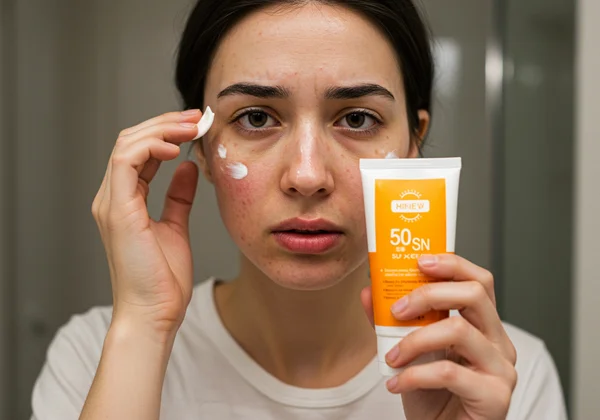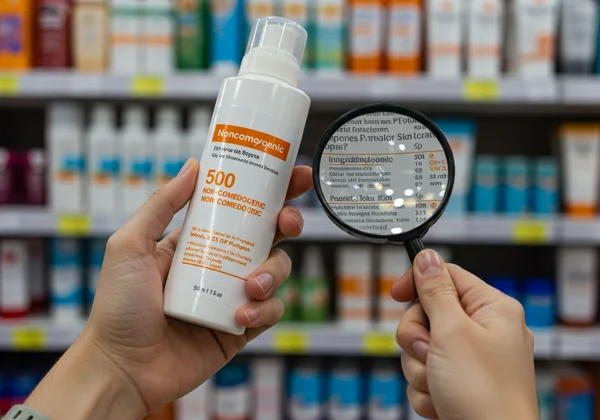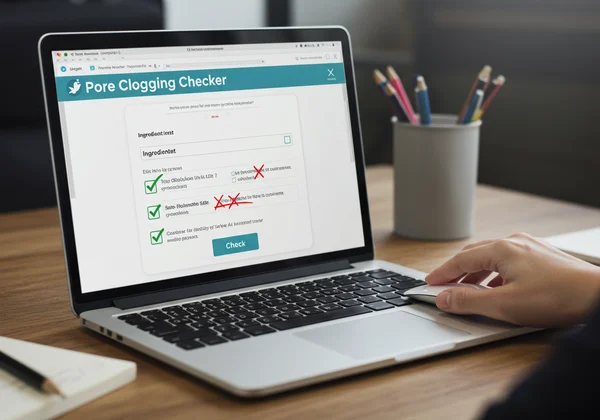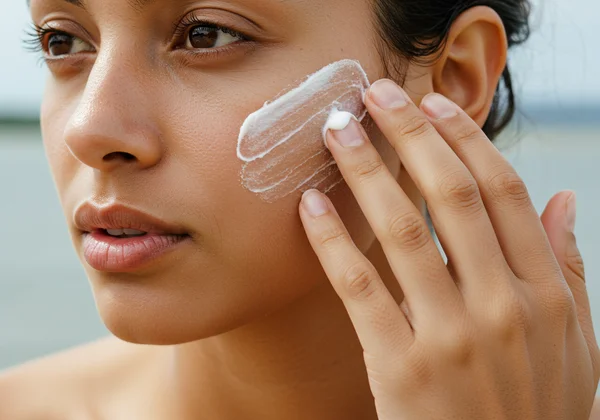Acne-Safe Sunscreen: Use Our Pore Clogging Checker Guide
Are you struggling with breakouts every time you use sunscreen? You’re not alone. Many sunscreens, while vital for skin health, contain hidden culprits that can lead to clogged pores and acne. This guide will reveal how to identify truly acne-safe sunscreen options and introduce you to a powerful, free tool to help you make informed choices. How to check if a product is pore clogging? Our pore clogging checker is designed to answer precisely that question, giving you the power to prevent future breakouts. Get ready to transform your skincare routine!

Why Sunscreen Can Clog Pores & Cause Breakouts
Sunscreen is a non-negotiable part of any healthy skincare routine, crucial for protecting against harmful UV radiation and preventing premature aging. However, for those prone to acne, finding a sunscreen that offers adequate sun protection without triggering new blemishes can feel like an impossible task. This often leaves people frustrated and, sometimes, they skip sunscreen entirely, which isn't good for skin health in the long run. Understanding the sunscreen pore clogging connection is the first step toward clearer skin.
The Essential Link Between UV Protection and Acne
The real challenge often comes down to the ingredients. While you need effective UV protection, some formulations can inadvertently lead to acne. This isn't because sun protection itself is bad, but rather due to specific components in many sunscreen products designed for stability, texture, or water resistance. These components, when left on the skin, can contribute to pore blockages, inflammation, and ultimately, acne breakouts. The key is to find formulations that deliver protection without compromise.
Common Sunscreen Ingredients to Watch Out For
Many ingredients found in sunscreens are known to be comedogenic, meaning they have the potential to clog pores. These can range from certain oils and emollients to some chemical UV filters. For instance, heavier oils like Coconut Oil or Shea Butter, while moisturizing, can be problematic for acne-prone skin. Similarly, some synthetic esters and silicones, though often used for their smooth texture, might contribute to blockages. Identifying what ingredients clog pores is crucial for choosing an acne-safe product checker. While remembering every single problematic ingredient is nearly impossible, being aware of the common culprits can guide your initial choices.
Decoding "Non-Comedogenic Sunscreen" Labels & Claims
Navigating the sunscreen aisle, you've likely seen labels proudly declaring "non-comedogenic." This claim is often a primary factor for individuals searching for an acne-safe sunscreen. But are noncomedogenic products really safe? While helpful, these labels don't always tell the whole story, leading many to believe a product is perfectly safe when it might still cause issues for their specific skin.

What Does "Non-Comedogenic" Truly Mean?
The term "non-comedogenic" suggests that a product has been tested and shown not to cause comedones (clogged pores that can lead to acne). However, it's important to understand that this testing isn't always standardized across the industry. Sometimes, it involves applying ingredients to rabbit ears (which react differently than human skin) or simply assessing individual ingredients rather than the final product formulation. For a truly effective comedogenic ingredient checker, you need more than just a label.
The Limitations of Sunscreen Product Labeling Alone
Even with "non-comedogenic" on the label, a product might still contain ingredients that irritate your specific skin type or cause a reaction when combined with other ingredients in the formula. This is where the need for a comprehensive skincare ingredient checker becomes apparent. Marketing claims can be misleading, and understanding the full ingredient list is the only way to be truly proactive in your skincare decisions. Labels provide a starting point, but an independent analysis tool offers unbiased, data-driven insights.
Your Guide to Checking Sunscreen Ingredients with PoreCloggingChecker
This is where PoreCloggingChecker steps in, offering an invaluable tool for every skincare enthusiast, especially those with acne concerns. Our pore clogging ingredient checker provides a free, objective analysis of your product's ingredient list, helping you identify potential irritants quickly and easily. This empowers you to check sunscreen ingredients like a pro.
Step-by-Step: Analyzing Your Sunscreen's Ingredient List
Using the PoreCloggingChecker is straightforward. Here’s how you can analyze your sunscreen:
-
Locate the Ingredient List: Find the full ingredient list on your sunscreen's packaging or its manufacturer's website. It's usually a long string of scientific names.
-
Copy the List: Carefully copy the entire list.
-
Paste into the Checker: Visit our homepage at analyze ingredients and paste the copied ingredient list into the designated input box.
-
Click "Check": Hit the "Check" button. Our powerful acne ingredient checker will instantly compare your list against its comprehensive database of known comedogenic ingredients.
-
Review Results: In seconds, you'll see a clear report highlighting any potential pore-clogging ingredients. This rapid analysis means you can quickly make informed choices, rather than spending hours researching individual compounds.

Interpreting Your Pore Clogging Checker Results for Sunscreen
Once you get your results, pay attention to the highlighted ingredients. Our tool clearly marks components known to be problematic. While an ingredient being flagged doesn't mean it will definitively cause acne for you (skin reactions are highly individual), it does indicate a higher risk. This knowledge empowers you to decide if you want to proceed with the product or seek alternatives. Use these insights to build a truly personalized, acne safe product checker routine. Our goal is to give you the data so you can confidently control your skincare journey. For more comprehensive analysis, feel free to use the checker for all your beauty products.
Beyond Ingredients: Tips for Acne-Safe Sunscreen Use
While identifying what ingredients should I avoid for acne-prone skin is crucial, how you use sunscreen also plays a significant role in preventing breakouts. Proper application and choosing the right formulation for your skin type can make a big difference.
Application & Reapplication Best Practices for Acne-Prone Skin
Even the most noncomedogenic checker approved sunscreen won't perform optimally if applied incorrectly. For acne-prone skin, a few best practices include:
-
Clean Skin First: Always apply sunscreen to freshly cleansed skin. Residual oil, dirt, or makeup can mix with sunscreen, increasing the likelihood of clogged pores.
-
Apply Adequately: Use a sufficient amount to get the stated SPF protection. Don't skimp on sunscreen – using too little defeats the purpose.
-
Gentle Application: Avoid rubbing or tugging vigorously, which can irritate sensitive, acne-prone skin. Pat or gently spread the product.
-
Reapply Regularly: Sunscreen wears off, especially with sweating or swimming. Reapply every two hours or immediately after water exposure to maintain protection.
-
Double Cleansing at Night: Thoroughly remove sunscreen (and makeup) at the end of the day. A gentle oil cleanser followed by a water-based cleanser can ensure no residue is left behind that could contribute to breakouts.

Choosing the Right Sunscreen Formulation for Your Skin Type
Sunscreen formulations vary widely, and choosing one that suits your skin type can significantly impact its performance and comfort.
- For Oily/Acne-Prone Skin: Look for lightweight, fluid, or gel formulations. Mattifying sunscreens can also be beneficial. Mineral sunscreens, containing zinc oxide and titanium dioxide, are often favored as they sit on top of the skin rather than being absorbed.
- For Dry Skin: Creamier, hydrating sunscreens can be more comfortable, provided they still pass the pore clogging checker test.
- For Sensitive Skin: Mineral sunscreens are generally less irritating than chemical sunscreens, making them a good choice. Always patch test new products.
Remember, the best sunscreen is the one you will actually use consistently. Don't hesitate to discover ingredients to find the perfect match for your skin.
Unlock Clearer Skin with Smarter Sunscreen Choices
Navigating the world of skincare, especially with acne concerns, can be challenging. Sunscreen, while essential, has historically been a source of frustration for many battling breakouts. However, by understanding the potential for sunscreen pore clogging and leveraging objective tools, you can finally choose products with confidence.
Our free online pore clogging checker empowers you to take control. No more guessing, no more relying solely on vague labels. With a simple copy-paste, you can instantly unveil the hidden culprits in your sunscreen and any other skincare, makeup, or hair product. Make smarter choices, prevent breakouts, and embrace a clearer, healthier complexion. Start your journey to truly acne-safe sunscreen and discover peace of mind by using our free check your products tool today!
Your Top Questions About Acne-Safe Sunscreen
How do I check if my sunscreen is pore clogging?
The easiest and most reliable way is to use our online pore clogging checker. Simply copy the full ingredient list from your sunscreen and paste it into our tool. It will quickly analyze the ingredients against a comprehensive database and highlight any known comedogenic substances, helping you identify potential pore-clogging culprits. Ready to start checking?
What ingredients should I avoid in sunscreen for acne-prone skin?
For acne-prone skin, it's generally best to avoid ingredients with high comedogenic ratings. Common culprits include certain oils (e.g., coconut oil, flaxseed oil), fatty acids (e.g., stearic acid), some emollients (e.g., isopropyl myristate, laureth-4), and specific silicones (e.g., dimethicone, depending on concentration and formulation). Using a comedogenic ingredient checker is the most efficient way to identify these.
Are sunscreens labeled "non-comedogenic" always safe for acne?
While "non-comedogenic" labels are a good starting point, they are not always a guarantee. Testing standards can vary, and what works for one person may not work for another. The best approach is to use a pore clogging ingredient checker to analyze the full ingredient list yourself, even for products labeled "non-comedogenic," to ensure it aligns with your skin's needs.
Can mineral sunscreens like zinc oxide and titanium dioxide clog pores?
Mineral sunscreens, which use zinc oxide and titanium dioxide as active UV filters, are generally considered less likely to clog pores compared to some chemical sunscreens. This is because they primarily sit on the skin's surface, forming a physical barrier, rather than being absorbed. However, the other ingredients in a mineral sunscreen's formulation (emollients, thickeners) can still be comedogenic. Always use a reliable skincare ingredient checker to verify the entire formula.
Disclaimer: This article is for informational purposes only and does not constitute medical advice. Always consult with a professional dermatologist or healthcare provider for any skin concerns or before making changes to your skincare routine.